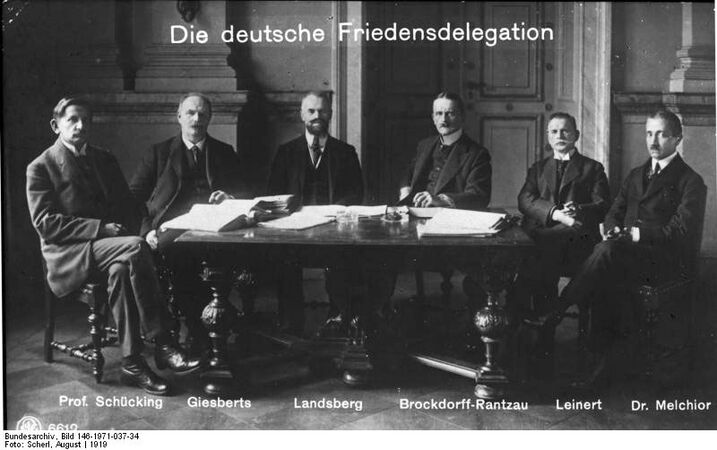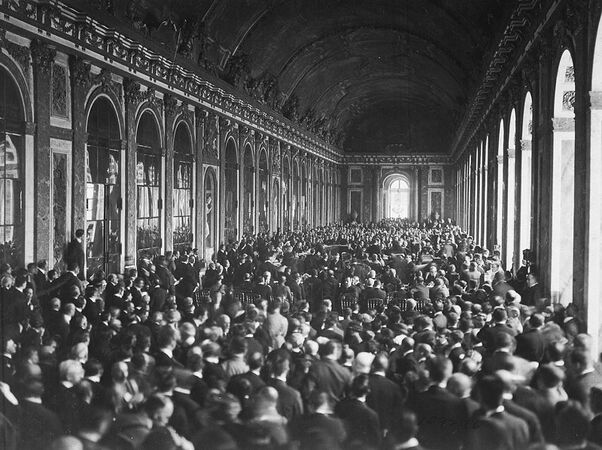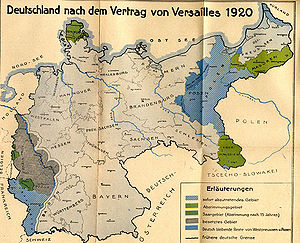

The peace treaty negotiated between the German Reich and the Allies since 18 January 1919, was signed on 28 June 1919 and came into force on 10 January 1920. The treaty provided, among other things, for the cession of territory and reparations, as well as the reduction in the number of troops. The peace treaty proved to be a heavy burden for the Weimar Republic, as nationalist forces instrumentalised it against the democratic form of government. The provisions of the peace treaty also affected Bavaria.
Military defeat in 1918 and request for a ceasefire
In August 1918, the Supreme Army Command assessed the military situation as hopeless. In September 1918, the emperor decided to start a "revolution from the top": a new imperial government based on parliament was to take the place of the one appointed by the emperor. Ceasefire negotiations were to be initiated in the hope of being able to reach an honourable understanding of peace. Under pressure from the Supreme Army Command, which considered the military collapse to be imminent, the Empire's first parliamentary government under Prince Max von Baden (1867-1929) submitted a request for an armistice to the Allies on 3 October 1918. The German side saw the Fourteen Points of US American President Woodrow Wilson (1856-1924) as the basis for peace negotiations.
In a message to Congress on 8 January 1918, the latter had outlined basic principles for a possible peace in Europe and, in doing so, had drafted, among other things, the demand for the peoples' right to self-determination and freedom of trade. As long as the Supreme Army Command still believed in a victory in the West, they had not paid any attention to Wilson's programme. Now it seemed to be an option to reach a moderate peace agreement. However, the political reality was missjudged. Great Britain and France's expectations for a peace agreement had to go beyond the programme presented by Wilson. The armistice was signed in the forest of Compiègne on 11 November 1918.
The Peace Treaty of Versailles
From 18 January 1919 on, the victorious powers of the First World War met in Paris, excluding the defeated. On 7 May 1919, the six main representatives of the German delegation to the peace negotiations were presented with a first draft of the treaty, which was the work of the three main political figures on the Allied side: US President Wilson, British Prime Minister David Lloyd George (1863-1945) and French Minister-President Georges Clemenceau (1841-1929). Since verbal negotiations were rejected by the Allies, objections could only be made in writing. However, all requests for changes by the German delegation were rejected.
-
German delegation at the Paris Peace Conference 1919 (Bundesarchiv - German Federal Archive) Bild 146-1971-037-34 / Scherl, August / CC-BY-SA 3.0)
-
The signing of the Peace Treaty of Versailles took place in the Hall of Mirrors on 28 June 1919. (Public domain through Wikimedia Commons)
The overall German delegation in Versailles included the Bavarian representative to the Reich Ministry of Economic Affairs, State Councillor in the Bavarian Ministry of Trade and later Minister of Trade Wilhelm von Meinel (1865-1927) as the "non-political representative of southern German economic interests". In addition, a number of representatives of business and science from Bavaria served as experts: BASF Chairman Professor Carl Bosch (1874-1940), MAN Director and French pre-war consul in Augsburg Dr Emil Guggenheimer (1860-1925), Director of the Munich Commercial College Professor Moritz Julius Bonn (1873-1965), political economy Professor Lujo Brentano (1844-1931) (then replaced by Max Weber [1864-1920]) and, as Bavarian expert for the issue of war blame General Count Max von Montgelas (1860-1938).
Under the pressure of sanctions from the Allies – the German side had been granted a period of acceptance of initially 5 and then 7 days after the handover of the final version of the treaty – the National Assembly in Weimar adopted the peace treaty on 23 June 1919 (237 to 138 votes, 5 abstentions).
Attempts by the Bavarian government under Minister-President Kurt Eisner (USPD, 1867-1919), to obtain more favourable conditions for a peace treaty within the framework of an independent foreign policy by mediating with the French or American governments in the run-up to the negotiations failed. The publication of Bavarian diplomatic secret files by the Bavarian government in the press was intended to represent an "open confession of guilt" and at the same time to enable a distancing from the Reich government's actions in Berlin. The published documents seemed to prove the imperial government's warmongering in the summer of 1914. The consequence was a storm of indignation throughout Germany at the Bavarian government's actions.
The 26 allied and associated powers as well as the German Reich signed the treaty on 28 June 1919. It came into force on 10 January 1920.
The peace treaty's provisions
The Treaty of Versailles assigned sole responsibility for the outbreak of the First World War to the German Reich and its allies in Article 231. It provided for large territorial cessions by Germany and temporary territorial occupations, the internationalisation of important German rivers and the renunciation of all colonies. As a result, the Reich lost about one seventh of its previous territory and 10% of its population. The loss of territory meant a weakening of the German economy, as important raw material deposits and production facilities were lost.
The Treaty of Versailles also provided for the extradition of suspected war criminals, the extradition of prisoners of war and the temporary demilitarisation of some German territories (e.g. the Rhineland). The strength of the German army was set at 100,000 men. Heavy weapons were prohibited for the troops.
In addition, the Treaty of Versailles burdened the German Reich with huge reparation payments, some of which had to be paid in kind. It also contained the statutes for the League of Nations, but without including Germany among its members.
The Bavarian Palatinate
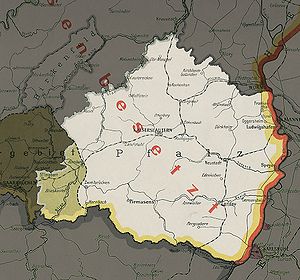
After the signing of the armistice on 11 November 1918, the immediate measures by the Allies had already affected Bavaria. The handover of railway material included the Bavarian State Railway on a pro rata basis, the handover of commercial ships included Bavarian river shipping. The Rhineland was occupied by the Allies, French troops occupied the Bavarian Palatinate. The state of occupation was only to end after 15 years, once all the peace treaty's provisions had been fulfilled and the area was then to be demilitarised. The Bavarian District President Theodor von Winterstein (1861-1945) was left in office, but was not allowed to continue to accept instructions from Munich. When attempts to separate the Palatinate from Germany as an independent state, supported and encouraged by the French, were resisted, high Bavarian officials, including Winterstein, were expelled from the Palatinate. Bavaria subsequently relied on close cooperation with the Reich government to be able to stand up for the Palatinate's concerns and interests.
The Palatinate returned to Bavaria with the "Young-Plan" (named after the economic adviser to the American President, Owen Young [1874-1962]), which provided for the settlement of the issue of the reparations in a new redemption plan designed for a longer period of time and in return offered the early evacuation of the occupied Rhineland on 30 June 1930. The Palatinate only finally left the federation with the Bavarian state with the proclamation of the foundation of Rhineland-Palatinate after the Second World War by the French military administration on 30 August 1946.
Bavaria and the peace treaty
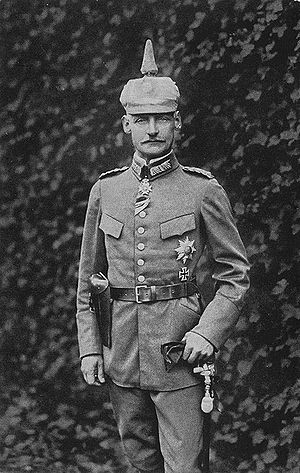
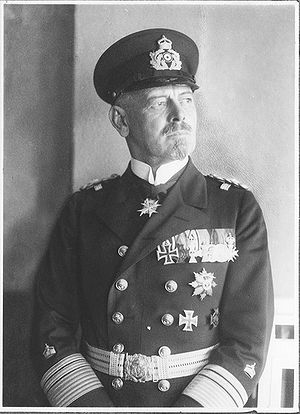
The Allies’ peace conditions were met with great horror in Bavaria, as well as throughout the Reich. The demands were initially considered generally unacceptable. There were protests particularly in the areas affected by occupation and planned secession. At the political level, a sense of the reality of power politics quickly returned. The Bavarian government under Johannes Hoffmann (SPD, 1867-1930) voted in favour of signing the treaty at a meeting of the Minister-Presidents of the Reich and the State Committee with the Reich government in Weimar on 19 June 1919. The majority of the public assemblies held in Bavaria on this subject also spoke in favour of adopting it. In the National Assembly vote, just two of the Bavarian members of the Zentrum/BVP parliamentary group voted against signing it.
The entry into force of the peace treaty brought about numerous changes for Bavaria. The Bavarian Palatinate remained occupied by French troops. St. Ingbert, Blieskastel and Homburg ("Saarpfalz"), a territory of more than 400 square kilometres with about 80,000 inhabitants, was added to the newly created Saar area and remained there permanently. With these cessions of territories, Bavaria lost a large part of its coal deposits and its iron and steel production. These losses became a great burden for Bavaria, which was otherwise largely agricultural. The internationalisation of German rivers, i.e. the management of the larger rivers by international bodies, made Bavaria's access to the important trade routes of the Rhine and Danube considerably more difficult.
Bavaria received a small degree of territorial compensation by the annexation of the Free State of Coburg on 1 July 1920.
The extradition of suspected war criminals also affected Bavaria. Crown Prince Rupprecht von Bayern (1869-1955), former army commander in France, Admiral Franz von Hipper (1863-1932) and other Bavarian generals and regiment commanders were to be charged with war crimes. However, a transfer of the proceedings to the Reichsgericht (Reich Court of Justice) was achieved through negotiations. In the end, all cases came to nothing.
Treaty of Versailles and Weimar Republic
The Treaty of Versailles, in particular the apportionment of blame in Article 231, which was actually formulated to safeguard the obligation to reparations under international law, gave the impression in Germany of a moral defamation of the German people. Representatives of all political parties and social groups considered the treaty to be unjust, as they were convinced that they had waged a defensive war. In the Weimar Republic, the modalities of its coming into being and the specific provisions led to extraordinary political tensions, which were fuelled in particular by Nationalists, National Socialists, right-wing conservatives and the military. Their aim was to destabilise the young democratic republic. The republican forces were accused that by signing the treaty they had made the humiliation of the German Reich and the denial of Germany's right to self-determination possible. It was precisely in these circles that the "peace of shame" of Versailles was equated with the existence of the Weimar Republic.
In this context, the "Dolchstoßlegende" (stab-in-the-back myth), which denied the historical facts, also gained popularity. Allegedly, the home front, meaning primarily the political left, pacifists and Jews, had stabbed the fighting troops in the back and made it impossible to continue the war. The "myth" proved to be an effective weapon in the hands of the Republic's opponents. Although, as a result of the German policy of rapprochement (1923-1925) under Foreign Minister Gustav Stresemann (DVP, 1878-1929), not all of the terms of the treaty had to be implemented and reparations payments were reduced or, in 1932, effectively stopped altogether, the Treaty of Versailles is considered the first German democracy's most difficult economic and political burden.
Evaluation of the peace treaty in historical research
The Peace Treaty of Versailles is judged in today's research to be both too harsh and too mild. The treaty proved to be a heavy burden for the young German democracy, without a doubt. At the same time though, the terms of the peace agreement were less rigorous than would have been possible under the circumstances. The treaty certainly had the character of a compromise, even if it did not correspond to the German unrealistic hopes for a mild "Wilson peace". Despite the treaty, the German Reich was able to retain its status as a major European power and, if it had been patient, could have played an active role in European politics again in the long term. The freedom of movement in foreign policy had even increased as a result of Russia's ousting from Central Europe and the continuing focus on domestic problems in Russia.
Evaluation of German sole blame
The question of blame for the war stirred up emotions in the Weimar Republic. The fight against the assignment of blame triggered a "world war of documents". The governments of the former combatants saw themselves increasingly compelled to publish key political documents from the years up to 1914 in file editions, primarily for apologetic reasons. Historical research was also politicised by the conflicts, former enemies of the war were more or less irreconcilably opposed to each other in this area as well, and they blamed each other. The National Socialist regime brought the scientific debate to a halt in the years 1933-1945.
After 1945, there was initially a consensus in history that it was not possible to establish a clear assignment of blame to one of the parties involved. The consensus was broken by the book "Griff nach der Weltmacht" by historian Fritz Fischer (1908-1999) of 1961. The starting point of Fischer's considerations was the question of Germany's aims in the war. Taking this into account, he came to the conclusion that the German Reich had deliberately considered and definitely intended a great war in an effort to achieve hegemony on the European continent. The subsequent discussion of the Fischer controversy developed into a "key debate" in West German research of contemporary history. Fischer's thesis, which became more and more rigorous in the course of the debate, was more likely to meet with approval abroad, while it was largely met with rejection at home.
Just in time for the 100th anniversary of the start of the war, the issue of war blame once again took centre stage in academic discourse. This was triggered by the book "The Sleepwalkers" (2012/2013) by Australian historian Christopher Clark (born 1960). In this book, the German Reich is no longer seen as the main culprit for the outbreak of war; instead, all relevant major powers of the time are considered to be more or less responsible. The outbreak of war is seen as a tragedy, not as the crime of one or more states. Political scientist Herfried Münkler (born 1951) expressed a similar view in his book "The Great War" (2013). As a result of this interpretation of historical events, a new battle broke out over the sovereignty of interpretation in the question of war blame. However, this brought neither a definitive clarification of the central question nor new scientific findings.
References
- Christopher Clark, Die Schlafwandler. Wie Europa in den Ersten Weltkrieg zog, München 2013 (originally published as The Sleepwalkers. How Europe Went to War in 1914, London 2012).
- Fritz Fischer, Griff nach der Weltmacht. Die Kriegszielpolitik des kaiserlichen Deutschland 1914/18, Düsseldorf 1961 (English translation: Germany's Aims in the First World War, 1967).
- Fritz Fischer, Krieg der Illusionen. Die deutsche Politik von 1911 bis 1914, Düsseldorf 1969.
- Helmut Gembries, Die Pfalz und Bayern in der Weimarer Zeit, in: Hans Fenske (Hg.), Die Pfalz und Bayern 1816-1956, Speyer 1998, 189-211.
- Peter Grupp, Vom Waffenstillstand zum Versailler Vertrag. Die außen- und friedenspolitischen Zielvorstellungen der deutschen Reichsführung, in: Karl Dietrich Bracher u. a. (Hg.), Die Weimarer Republik 1918-1933. Politik, Wirtschaft, Gesellschaft. Bonn 3. Auflage 1998, 285-302.
- Eberhard Kolb, Der Frieden von Versailles, München 2005.
- Wolfgang Michalka, Deutsche Außenpolitik 1920-1933, in: Karl Dietrich Bracher u. a. (Hg.), Die Weimarer Republik 1918-1933. Politik, Wirtschaft, Gesellschaft, Bonn 3. Auflage 1998, 303-326.
- Herfried Münkler, Der Große Krieg. Die Welt 1914-1918, Berlin 2013.
- Wolfgang Zorn, Bayerns Geschichte im 20. Jahrhundert. Von der Monarchie zum Bundesland, München 1986, 210-232.
Sources
Further Research
External Links
- Bundeszentrale für politische Bildung (Federal Agency for Civic Education): Dossier on the Paris Peace Order.
- German Stories: 1919-1933; Versailles, Treaty of Versailles.
- Deutsches Historisches Museum (German Historical Museum) - Living Museum Online: The Treaty of Versailles.
- Deutschlandfunk: The Burden of Versailles - 100 Years since the Peace Treaty.
- DokumentArchiv.de: Peace Treaty of Versailles ("Treaty of Versailles"), 28 June 1919.
- Portal for contemporary witnesses: The Treaty of Versailles (© ZDF).
Related Articles
- Demobilmachung, 1918-1923 (ökonomisch, gesellschaftlich, kulturell)
- Münchner Universitätskrawalle, 1931
- Reparationen (Weimarer Republik)
- Young-Plan, 1929/30-1932
Vertrag von Versailles, Friedensvertrag von Versailles
Cite
Patrick Henßler, Treaty of Versailles, 1919/20, first published 04 September 2007, english version published 30 November 2023; in: Historisches Lexikon Bayerns, URL: <https://www.historisches-lexikon-bayerns.de/Lexikon/EN:Treaty_of_Versailles,_1919/20> (21.12.2025)

